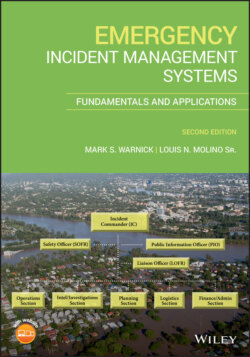Читать книгу Emergency Incident Management Systems - Mark Warnick S., Louis N. Molino Sr - Страница 37
1.9 The Melding of the IMS Concepts of Today
ОглавлениеThe Big Three concepts of incident management were directed toward specific uses, but initially none of these concepts were perfected for all types of incidents. Some believe that the underpinnings of each of those “Big Three” evolved and melded together over the past 40 years. It is important to note that these concepts did not evolve in a linear format, where it was one dimensional. These three initial types of incident management seemed to evolve in a more three‐dimensional fashion, and in a concurrent way. This three‐dimensional growth began to incorporate more than just fire departments. As it developed, it began to show the utilitarian use of the system for myriad of agencies who might be utilized on an emergency incident.
The Incident Command System (ICS) was originally created for the fire service. Over the years, it became widely used, and accepted, by fire agencies throughout the United States. As other public safety disciplines began to understand the utility and the benefits of the system, its use became more prevalent in these disciplines. While some minor changes were made to make ICS more useful by other disciplines, the main concepts remained the same. The system soon began to be incorporated by law enforcement, hospitals, Emergency Management Agencies (EMA), public works, faith‐based organizations, and other stakeholder agencies. As the effectiveness of the system became more realized, ICS gradually found its way into nonpublic safety function such as concerts, festivals, marathons, and other event management activities.
In 1980, the original FIRECSOPE method and other existing IMS methods transitioned into a national program called the National Interagency Incident Management System (NIIMS). NIIMS temporarily became the backbone of a wider‐based method for all federal agencies having a role in wildland fire management. This was initially administered by the US Department of the Interior through its National Wildfire Coordinating Group (NWCG) which is based in Boise, Idaho. NIIMS was endorsed and used by multiple agencies in the United States until shortly after September 11 attack.
The most unthinkable incident occurred on 11 September 2001, changing the world as we knew it, forever. This catastrophic incident changed the way that we manage emergency incidents. This was partially due to the problems that developed in the aftermath of the 9/11 attacks, and many of these changes were made based on the shortcomings that were identified while trying to recover from this immense incident.
While the way of managing any incident was to utilize the ICS method, after the September 11 attacks, it became apparent that another way of more effectively integrating resources was needed. Even after the attacks, it was realized that ICS should remain the way to manage an incident at the local level because it worked, and worked well. Even so, the shortcomings of integrating resources from around this great nation of ours was quickly realized after the attacks. It was also realized that a national method, or national set of protocols, was needed to integrate outside resources in a more organized manner.
These set of concepts, known collectively as the National Incident Management System (NIMS) has become even more necessary since the September 11 attacks. This necessity was not only relegated to the United States but also around the world, especially considering the most recent terrorist attacks and major emergencies that continue to occur. The concepts that drive NIMS is still, and (most likely) will forever be, developing. The primary reason for this is because of the ever‐changing threats that first responders face.
After the events of 9/11, the Federal Emergency Management Agency's (FEMA's), National Curriculum Advisory Committee on Incident Command Systems/Emergency Operations Management Systems recommended adoption of ICS as a multihazard all‐agency system. The initial reaction to recognize ICS as the nationwide way of managing incident was swift, and it was supported by several key agencies and/or organizations. These actions included
FEMA's National Fire Academy (NFA) adopted the ICS/NIMS as a model system for fire services. This is important because the NFA served as a focal point for federally based incident command and management training. The NFA accomplished this through a variety of models of training delivery both on its Emmitsburg, Maryland, campus and through its off‐campus training delivery system.
FEMA's Urban Search and Rescue (USAR) Response System, a component of the Federal Response Plan. At the time of the September 11 attacks, USAR used NIIMS as the basis of its onsite management structure. They utilized the NIIMS system to allow for seamless interface with the local Incident Management System. When the discussion turned to a nationwide single system, most USAR Teams welcomed it with open arms.
The National Fire Protection Association (NFPA). The NFPA created life safety standards for many years. Prior to the September 11 attacks, many NFPA Standards referenced or in some cases directly called for the development and use of an incident management system. When the adoption of ICS and NIMS as the nationwide way of managing emergency incident was suggested, the NFPA wholeheartedly supported it.
The use of NIIMS was then relied upon by only certain federal government agencies, that is, until a Presidential Directive by President George W. Bush. President Bush mandated a standardized incident management system through Executive Order. Prior to this mandate, many federal agencies incorporated the structure of emergency incident management for which they felt best suited their objectives and needs.
These emergency incident management systems of that time created a hodgepodge of methods that, in many instances, did not integrate well with other types of emergency incident systems. Whether this lack of integration was caused by human error or was a product of poor incident management design (or a combination of the two) is still a matter of debate. After the September 11 attacks, it became increasingly important to integrate, and to make sure that everyone was working from the same playbook.
